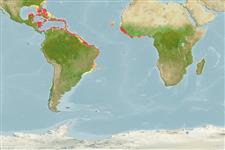Environment: milieu / climate zone / depth range / distribution range
Ecologia
marino associati a barriera corallina; distribuzione batimetrica 0 - 100 m (Ref. 5979), usually 0 - 20 m (Ref. 40849). Tropical; 34°N - 25°S, 91°W - 5°E
Western Atlantic: Florida (USA), Bermuda, and the Bahamas to Brazil. Absent in Gulf of Mexico (Ref. 26938). Eastern Atlantic: Ascension Island and the Gulf of Guinea (Ref. 5979).
Size / Peso / Age
Maturity: Lm ? range ? - ? cm
Max length : 46.0 cm TL maschio/sesso non determinato; (Ref. 5979); common length : 35.0 cm TL maschio/sesso non determinato; (Ref. 3275)
Raggi dorsali molli (totale) : 92 - 99; Raggi anali molli: 71 - 76. Gray to brown with numerous circles, curved spots, and dots of light blue on head and body; fins with small light blue spots; two or three large diffuse blackish spots on straight portion of lateral line (Ref. 13442).
Inhabits clear sandy areas near mangroves, among seagrass, coral or rubble (Ref.9710). Most common flounder around coral reefs (Ref. 26938). Often partially buried in sand, occasionally on hard bottoms (Ref. 9710). Feeds mainly on small fishes but also on crustaceans and octopuses. Marketed fresh (Ref. 5217).
Life cycle and mating behavior
Maturità | Riproduzione | Deposizione | Uova | Fecundity | Larve
Robins, C.R. and G.C. Ray, 1986. A field guide to Atlantic coast fishes of North America. Houghton Mifflin Company, Boston, U.S.A. 354 p. (Ref. 7251)
IUCN Red List Status (Ref. 130435: Version 2024-1)
Threat to humans
Harmless
Human uses
Pesca: scarso interesse commerciale; Acquario: Commerciale
Strumenti
Special reports
Download XML
Fonti Internet
Estimates based on models
Preferred temperature (Ref.
123201): 25.2 - 28, mean 27.3 °C (based on 368 cells).
Phylogenetic diversity index (Ref.
82804): PD
50 = 0.5000 [Uniqueness, from 0.5 = low to 2.0 = high].
Bayesian length-weight: a=0.01047 (0.00567 - 0.01934), b=3.08 (2.92 - 3.24), in cm total length, based on LWR estimates for this species & Genus-body shape (Ref.
93245).
Trophic level (Ref.
69278): 4.5 ±0.7 se; based on diet studies.
Resilienza (Ref.
120179): Molto basso, tempo minimo di raddoppiamento della popolazione più di 14 anni (Preliminary K or Fecundity.).
Fishing Vulnerability (Ref.
59153): Moderate vulnerability (36 of 100).
Nutrients (Ref.
124155): Calcium = 36.4 [14.1, 67.1] mg/100g; Iron = 0.475 [0.216, 0.877] mg/100g; Protein = 18.3 [16.8, 19.9] %; Omega3 = 0.0843 [, ] g/100g; Selenium = 35.7 [17.0, 81.7] μg/100g; VitaminA = 109 [26, 452] μg/100g; Zinc = 0.739 [0.471, 1.122] mg/100g (wet weight);
